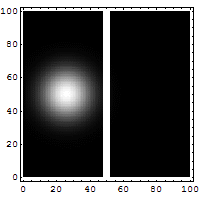Quantum tunnelling facts for kids
Quantum tunneling is a super cool idea from physics. It's part of a field called quantum mechanics. Imagine a tiny particle, like an electron, hitting a wall. Normally, it would just bounce back. But in quantum tunneling, if the wall is super thin, the particle can sometimes go right through it!
This happens because tiny particles don't just act like solid balls. They can also act like waves. And because of the rules of quantum mechanics, there's a small chance they can appear on the other side of a barrier. It's like they "tunnel" through it, even without enough energy to climb over it.
This amazing effect mostly happens with very, very tiny things, like subatomic particles. For bigger objects, like you or a basketball, the chance of tunneling through a wall is so incredibly small that it never happens.
Contents
What is Quantum Tunneling?
Quantum tunneling is a special event in the world of tiny particles. It's when a particle passes through an energy barrier. This barrier would normally stop it. But the particle doesn't need to "jump over" the barrier. It can just go through it.
How Does It Work?
Think of a ball rolling up a hill. If it doesn't have enough speed, it rolls back down. It can't get to the other side. Quantum tunneling is different for tiny particles. It's like the ball can sometimes appear on the other side of the hill, even without enough speed.
This is because of how quantum mechanics works. Particles at this tiny level don't always have a exact position. They have a chance of being in different places. This chance is called probability. So, there's a small chance a particle can be found on the other side of a barrier.
Particles as Waves
One key idea is that tiny particles can act like waves. When a particle acts like a wave, it can spread out. This wave can "leak" through a thin barrier. When it comes out the other side, it becomes a particle again.
Why Is It Important?
Quantum tunneling might sound like science fiction. But it's a real thing! It's very important in how many modern technologies work. For example, it helps explain how the Sun makes energy. It's also used in tiny electronic devices.
Where Do We See Quantum Tunneling?
Quantum tunneling isn't just a theory. It's observed in many places. It's vital for how stars like our Sun shine. It also plays a role in some very small electronic parts.
In the Sun
Inside the Sun, tiny particles called protons need to join together. This process creates the Sun's energy. But protons usually push each other away. They need to get very close to join. Quantum tunneling helps them get close enough. It lets them "tunnel" through their natural repulsion.
In Technology
Scientists use quantum tunneling in many cool inventions. One example is the scanning tunneling microscope. This special microscope can see things that are incredibly small. It works by using electrons that tunnel through tiny gaps. Another example is a resonant tunnelling diode, which is a super-fast electronic switch.
Images for kids
See also
 In Spanish: Efecto túnel para niños
In Spanish: Efecto túnel para niños







